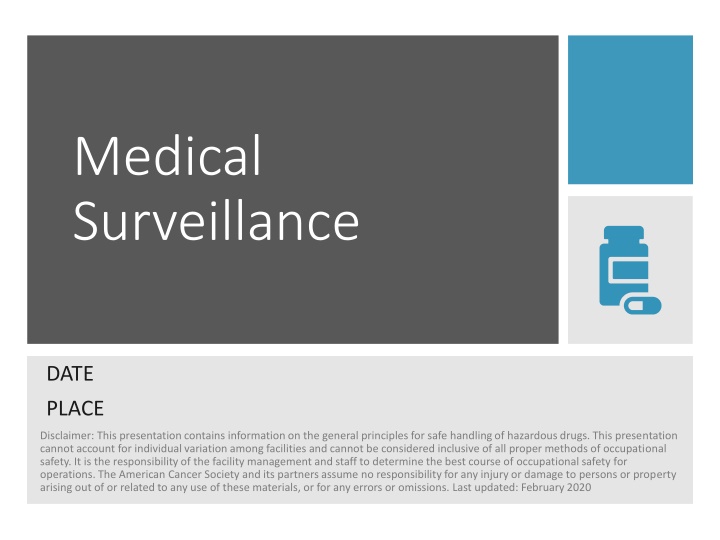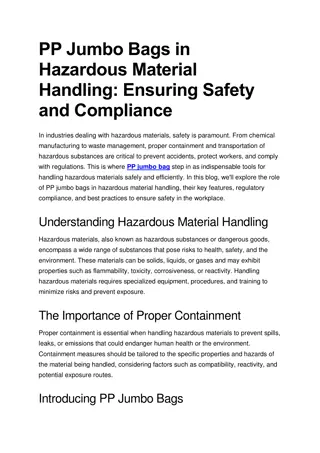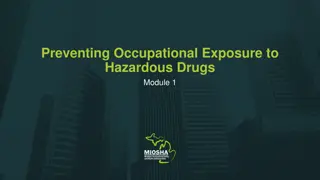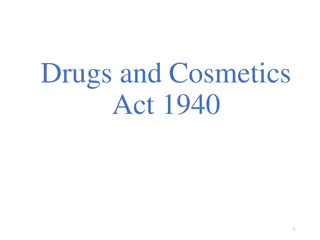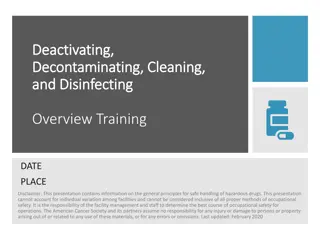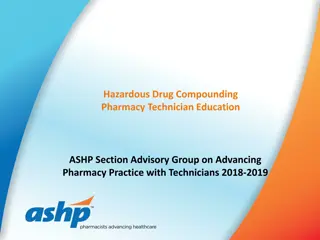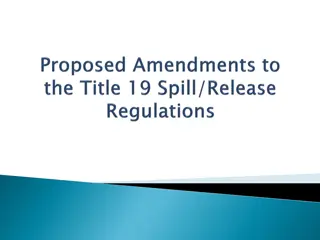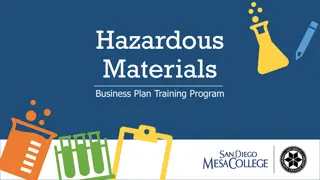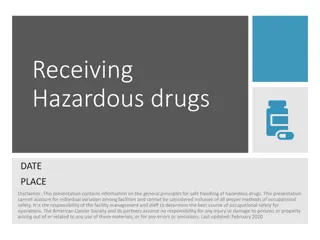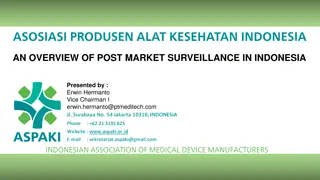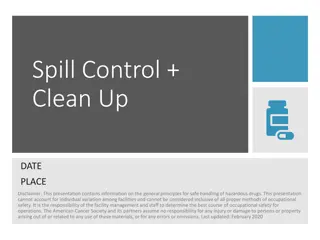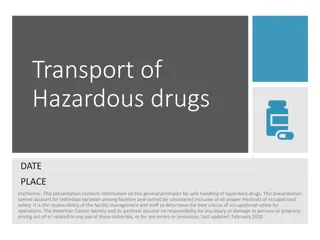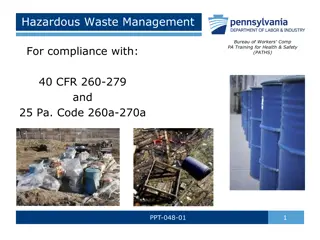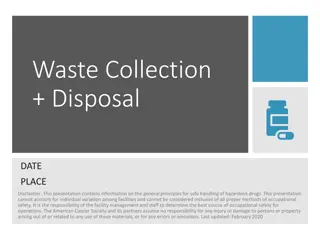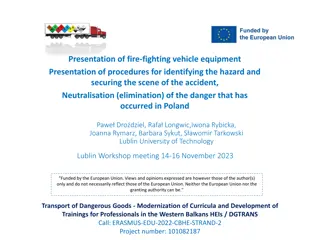Safe Handling of Hazardous Drugs in Medical Surveillance
This presentation provides information on essential components of a medical surveillance program for safe handling of hazardous drugs, including criteria for medical evaluations, documentation, and staff training. It emphasizes the importance of maintaining worker lists, conducting observations, and documenting incidents to ensure occupational safety in healthcare settings.
Download Presentation

Please find below an Image/Link to download the presentation.
The content on the website is provided AS IS for your information and personal use only. It may not be sold, licensed, or shared on other websites without obtaining consent from the author.If you encounter any issues during the download, it is possible that the publisher has removed the file from their server.
You are allowed to download the files provided on this website for personal or commercial use, subject to the condition that they are used lawfully. All files are the property of their respective owners.
The content on the website is provided AS IS for your information and personal use only. It may not be sold, licensed, or shared on other websites without obtaining consent from the author.
E N D
Presentation Transcript
Medical Surveillance DATE PLACE Disclaimer: This presentation contains information on the general principles for safe handling of hazardous drugs. This presentation cannot account for individual variation among facilities and cannot be considered inclusive of all proper methods of occupational safety. It is the responsibility of the facility management and staff to determine the best course of occupational safety for operations. The American Cancer Society and its partners assume no responsibility for any injury or damage to persons or property arising out of or related to any use of these materials, or for any errors or omissions. Last updated: February 2020
Staff who supervise workers with potential exposure to hazardous drugs Who should take this training? These staff may include facility administration, physicians, lead pharmacists, and lead nurses 2
Training Modules + Learning Objectives Essential Components of a Medical Surveillance Program List the six essential components of a medical surveillance program Determine criteria for medical evaluation screenings Medical Screenings Identify the types of documentation used in medical surveillance programs Documentation 3
Essential Components of a Medical Surveillance Program
Six Essential Components of a Medical Surveillance Program Maintain a list of all workers who are exposed to HDs as a part of their job assignment Have all HD handlers complete periodic questionnaires Conduct periodic observations of drug preparation and administration practices 5 Reference 2
Six Essential Components of a Medical Surveillance Program Carefully document spills, spill cleanup activities, and accidental exposure Confidentially share the results of medical surveillance with the employees who handle HDs Develop policies that guide employees in how to pursue surveillance through their primary care providers in settings without employee health services 6 Reference 2
Medical Screenings
Why do we conduct medical screenings? The purpose of screening is to identify the earliest reversible biologic effects so that exposure can be reduced or eliminated before the employee sustains irreversible harm. 8 Reference 1
Medical screening is typically conducted: At the time of job termination or transfer (exit examination) Periodically during employment Following acute exposures Before job placement 9 Reference 1
Those handling HDs in the workplace should have an initial evaluation consisting of: MEDICAL AND WORK HISTORY BASELINE PHYSICAL EXAM LABORATORY STUDIES 10 Reference 1
The history details The history details the individual s: the individual s: Medical and reproductive experience with emphasis on potential risk factors Complete occupational history, with information on the extent of past exposures MEDICAL AND WORK HISTORY Use of protective equipment Reference 1 11
Estimates of worker exposure, in the Estimates of worker exposure, in the absence of environmental sampling absence of environmental sampling data, may include: data, may include: Records of drugs and quantities handled Hours spent handling these drugs per week MEDICAL AND WORK HISTORY Number of preparations or administrations per week Over-exposure events 12 Reference 1
An initial physical examination An initial physical examination focuses on: focuses on: Targeted organ systems of commonly used drugs: the skin, mucous membranes, and lymphatic systems Other organ systems suggested from the medical history BASELINE PHYSICAL EXAM An evaluation for respirator fit 13 Reference 1,3
The examining physician should The examining physician should document: document: A description of the employee's duties as they relate to the employee's exposure The employee's exposure levels or anticipated exposure levels A description of any PPE used or to be used BASELINE PHYSICAL EXAM Information from previous medical examinations of the employee 14 Reference 1
The most valuable test in a laboratory assessment is a complete blood count with differential. Other laboratory testing (liver function tests, blood urea nitrogen, creatinine, and a urine dipstick for blood) may sometimes be appropriate. LABORATORY STUDIES 15 Reference 1,4
Test that are not recommended are not recommended in routine surveillance: Measures of genetic effects Biological monitoring Reference 1 16
Periodic follow-up The medical, reproductive, and exposure history should be updated on a periodic basis, every one to three years. The interval between exams of individual workers depends on the opportunity for exposure, the duration and intensity of exposure, and (possibly) the age of the worker. Reference 1 17
Where workplace-based medical surveillance programs are limited, workers who handle HDs should be encouraged to inform their personal healthcare providers about their occupation and possible HD exposure in the course of their routine personal medical care. Reference 5
Documentation should include: Staff Health monitoring Exposure to cytotoxics Education and training Facilities Microbiological monitoring Contamination monitoring Maintenance log Temperature logs Particle counts Qualification and re-qualification Reference 6,7 20
Documentation should include: Transport Outside the institution Within the institution Cleaning Cabinet/isolator Sterile room Reference 6,7 21
Documentation should include: WORKLOAD STATISTICS PROCEDURE MANUAL SAFETY DATA SHEETS CYTOTOXIC SPILLS EXTRAVASATION Reference 6,7 22
23 1. United States Occupational Safety and Health Administration. Controlling Occupational Exposure to Hazardous Drugs [Internet]. [cited 2018 May 5]. 2. Pan American Health Organization. Safe handling of hazardous chemotherapy drugs in limited-resource settings [Internet]. 2013. 3. Respiratory Protection. - 1910.134 | Occupational Safety and Health Administration [Internet]. [cited 2018 May 18 References 4. Polovich M, Olsen M, editors. Safe handling of hazardous drugs. Oncology Nursing Society; 2018 5. ASHP (American Society of Health System Pharmacists). Guidelines on handling hazardous drugs. Am J Health Syst Pharm. 2006;63:1172 93. 6. US Pharmacopeia. USP General Chapter <800> Hazardous Drugs- Handling in Healthcare Settings [Internet]. 2017 [cited 2018 May 7]. 7. Connor T, McLauchlan R, Vandenbroucke J. ISOPP Standards of Practice: Safe Handling of Cytotoxics. J Oncol Pharm Pract. 2007;13(1).
